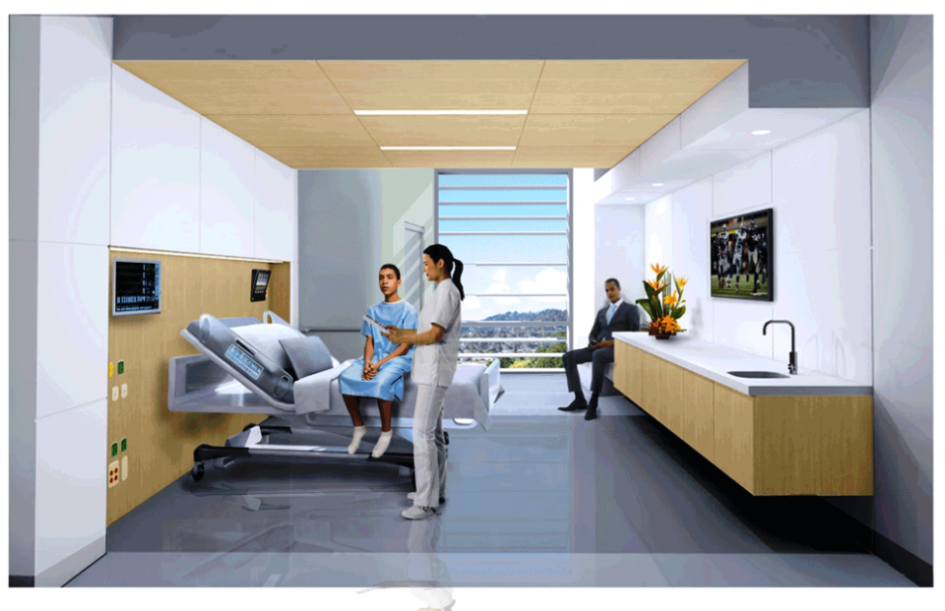Construction on Marin General Hospital’s new $535 million MGH 2.0 hospital replacement building is underway at the facility's campus in Greenbrae CA. Led by general contractor McCarthy Building Companies; architect Perkins Eastman, Inc; and SWA Group as the landscape architect, the project is slated to open for patient care in mid-2020.
Phase 1 of the job includes a new modernized four-story, 260,000-sq-ft hospital replacement building. The new towers will house 114 private rooms, an expanded emergency department and six new operating/procedural suites. Special amenities and landscape features, such as rooftop gardens, balconies, and natural light in every patient room, will create a "healing environment for patients and families."
McCarthy recently completed a five-and-half-level, net-zero parking structure with roof-top solar panels that will support the current and future hospital.
Crews are currently working on earthwork and shoring around the West Wing portion of the job. This area is the make-ready portion of the overall project. McCarthy's team is now preparing for the connection point to the new hospital. "The focus is on hospital shoring installation and site preparation for the start of foundations and site winterization," says Simon Gregson, McCarthy project director.
Gregson told me that the first major construction milestone will come at the end of September, when they begin actual foundation work. He says by the first of the year, they should be wrapping up foundations and looking forward to structural steel erection in February, and also working on underground utilities as well as an offsite exterior performance mock-up.
The original hospital, first opened in 1952, will continue to operate throughout the construction process. The hospital's CEO Lee Domanico said in a news release that the project will satisfy "rigorous new regulations in health care and seismic safety" for hospitals that must be met by the 2030. After the new hospital towers open in 2020, work will begin on a five-story, 100,000-sq-ft ambulatory services building and a second parking structure.
The project is pursuing LEED Silver certification. Sustainable features include capturing storm water runoff; photovoltaic panels on one of the new parking structures; environmentally-friendly substances, such as low-emitting materials, adhesives, sealants, paints and flooring; and water-efficient landscaping, with ample green spaces on the grounds and rooftops, and the elimination of the use of potable water for landscape irrigation.
As far as challenges, Gregson points to the shoring system and the build-out of the sunken garden.
"Its proximity to the existing facility, excavation in hard rock, and complex concrete work make for a challenging build," he says. "The topography in the area adds an additional layer of complexity."
Gregson says much effort is going into creating and constructing a facility that aligns with Marin’s culture and existing facility while providing an up to date state-of-the-art facility with a hospitality feel.
"The design team has gone to great lengths in order to ensure that the beauty of Marin’s natural environment is brought indoors to enhance patient healing," he says. "The recently completed parking structure blends into the hillside and as one drives by it is hard to notice that a parking structure was just completed."
He says the new hospital’s "complex exterior" has a similar feel to the current West Wing structure while adding shading and privacy to patients and providing outdoor balconies with views of Mt. Tamalpais. He says new roof gardens and the sunken garden will provide outdoor healing spaces for patients on all levels of the new facility.
"During construction, the team will be challenged with the tie-in to the West Wing make-ready, and building on a site with an operational hospital," says Gregson. "In order to mitigate challenges, the team has formed close relationships with the facilities team."
He says in order for the team to better combat the challenge of elevation changes of the sunken garden, they have modeled the existing facility and terrain as well as the shoring. "The team has used this model not only to aid in the fabrication and procurement of tie-backs but also for planning of sequencing," says Gregson. "A 4D model has been developed so that the entire team can better understand the sequence of installation."


Post a comment to this article
Report Abusive Comment